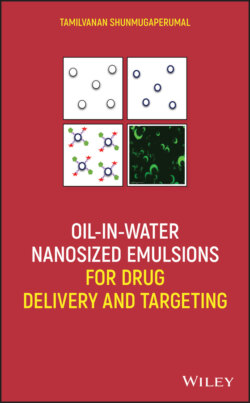Читать книгу Oil-in-Water Nanosized Emulsions for Drug Delivery and Targeting - Tamilvanan Shunmugaperumal - Страница 33
2.2.6. “Stealth” Property of Nanosized Emulsions: In Vitro Demonstrations
ОглавлениеAnionic emulsion formulations capture apolipoproteins (apo) along with other plasma proteins within minutes after an infusion in human blood, facilitating their fast elimination. In contrast, cationic emulsions reveal a much longer retention time in the plasma. Moreover, cationic colloidal carriers can promote the penetration of therapeutic agents into cell surfaces possibly via an endocytotic mechanism (Calvo et al. 1997). To improve the API targeting efficacy of colloidal carriers of anionic emulsions and to further prolong the circulating effect of the cationic emulsions, a mixed stabilizer film at the oil–water droplet interface composed of nonionic Poloxamer 188 and ionic lipoid E80 and stearylamine/oleylamine was created by combining the effects of electrostatic and steric barriers at the oil–water interface (Tamilvanan et al. 2005). In order to prove this concept, surface (charge)‐modified o/w nanosized emulsions (cationic and anionic) were prepared following the well‐established combined emulsification techniques (de novo) and these two emulsions were characterized for their droplet size distribution and surface charge. Marketed lipofundin MCT 10%, deoxycholic acid‐based anionic emulsions, oleylamine‐/stearylamine‐based cationic emulsions, and oleic acid‐based anionic emulsions were selected in this study. The effect of these emulsions on in vitro adsorption of plasma proteins was investigated by means of two‐dimensional polyacrylamide gel electrophoresis (2D PAGE).
Competition between steric repulsion by poloxamer and electrostatic attraction by ionic components led to the sensitive adsorption of small molecular weight proteins like apo, albumins by the surface of colloidal carriers whereas all emulsion droplets were effectively shielded from the adsorption of larger proteins like immunoglobulins, fibrinogen, etc., enhancing the shelf life of emulsion formulations in the blood (Fig. 2.2). The apoA‐I along with apoA‐IV have been suggested to modulate the distribution of apoE between the different lipoprotein particles in the blood and thereby affect their clearance (Tamilvanan et al. 2005). In addition, the attachment of apoE would greatly alter the in vivo distribution of fat emulsions since this protein is a ligand for the apoE‐specific receptors on the liver parenchymal cells. The higher the preferential adsorption of apoA‐I onto the cationic emulsion droplets, the more intensified the displacement/redistribution of apoE would, therefore, be expected to occur on these types of cationic emulsion formulations in the blood (Tamilvanan et al. 2005). Indeed, the ratio of apoA‐I to apoA‐IV was very close to 1 for Lipofundin® MCT 10% whereas it was about 0.26 for deoxycholic acid‐based anionic emulsion and above 5 for oleic acid‐based anionic emulsion and both cationic emulsions. This indicates that emulsions having similar surface/interfacial charge imparted by different anion‐forming stabilizers (oleic or deoxycholic acids) exhibited markedly different protein adsorption patterns.
Figure 2.2. Amount of major proteins on the 2‐D gels of plasma proteins adsorbed on emulsions with negative or positive surface charge in comparison with Lipofundin MCT 10%.
[Taken with permission from Elsevier (Tamilvanan et al. 2005).]
